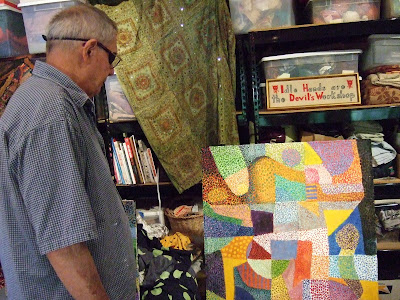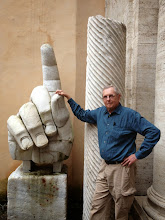Why is Art History so hard? The Professor's survey class always loses two-thirds of is students. Why? Because, students must use their eyes and mind and must use both symbolic and comparative thinking. This Art business demands cognitive skills.
To Fix the Space 18x24
Everything the Professor paints or teaches is derived from things he has digested from his peers. People can easily point out from whom or what he is borrowing. Where ever you turn someone has already been there. It is all one's personal discovery, yet the Professor sees that many people do not understand that what they are doing is simply copying or playing mind games with themselves and supposedly the viewers.
The Professor likes Duchamp, but he hates what his ideas have fostered, making art a silly mind game and yes, everyone can be an artist, so therefore, what is art? Whatever I say it is and so????
The Professor's years in Santa Fe and visits to other tourist driven art destinations taught him the treachery of the market. He saw knock-off of knock-offs of knock-offs. It all seems so easy. Take a class and you become an artist. Your friends will be impressed. Maybe one of them will open a gallery. Perhaps they have lots of money to burn and need a tax right off or perhaps a social 'lift'. In a market driven art world, why not? If someone has a gimmick, why not use it? The clientele usually does not know the difference. They just want the stuff to behave itself and blend into the surroundings. And please, let the art not be disruptive or disturbing.
Well, in typical tourist markets, people do not to be confronted. They want to feel good and they do not want real intellectual stimulation. The Professor was looking at the Matisse catalogue from MOMA and realized this type of work could never be shown in either Santa Fe or a city such as Houston. The work the Professor sees in the MOMA catalogue is too rough, too ground breaking, too confrontational for a sales driven gallery. He thinks about that a lot. Galleries must sell, artists want to sell. What to do? Happily, the Professor has a job. He is free to paint whatever he wishes. He puts his paintings in storage and makes another.
Here are some pictures from today, until he over did it....having too much of a good time... and his back drove him to the heating pad.

Tonight, the Professor is feeling better again. It's a new painting day tomorrow.













Very true. And those circles on the white background look really cool. Take care with your back. Squat instead of bending and strecht a lot....cat like = ^..^ =
ReplyDeleteThe studio is a riot of color and you look quite pleased! Your collage of canvases may not be a new concept but they are definitely original.
ReplyDeleteEarl, Duchamp also supposedly said,"Les marchands d'art sont les poux sur les dos des artistes". (Art dealers are lice on the backs of artists.) MD, like Jesus, was the real thing, but as soon as his followers assembled in imitation, things began to get fouled up, until everything became, ironically, the opposite of the original. The only truth left standing is that artists must be honest with themselves and undaunted by trends and perfidious audiences. Another great irony is, as you pointed out, when you have a job you are free to imagine and create as you will, unbound by demands made by the marketplace. Even Picasso's dealer, Paul Rosenberg, refused to show the canvas "Woman Lying in the Sun", saying "...je refuse d'avoir des trous de cul dans ma galerie". The painting would hardly raise an eyebrow these days, but the point is that dealers never really have open minds. They are in business, and in that sense there isn't much difference between them and shoe salesmen.
ReplyDeleteStay free.
AF
Always a pleasant visit with the Professor.
ReplyDeleteThis from Andy:
ReplyDeleteEarl, I posted something on your blog yesterday....did you get it in your mailbox? Part of what I said was about dealers. Don't take these galleries and their activities to heart. The artists they are showing will clearly reflect a continued and current commercial connection with the galleries. Since neither Moody nor Texas Gallery stands to make money if they feature some of your work, they will not include you. Texas Gallery showed my work for five years, but I don't expect them to include me. That's ok.
I was excluded from a retrospective of the "Perspectives" shows at the CAMH in 2004. That was rude, but I have come to expect inconsiderate behavior from them. The MFAH is the same. Both museums are still shamelessly attached to a small coterie of dealers.
Please just keep working and let these people go. You'll live longer if you do. Things have a funny way of correcting themselves eventually in ways that we cannot imagine or foresee.
From HJ Bott:
ReplyDeleteEARL:
I'm sorry to hear this about the omissions, and I was steamed that Hooks
left me out of her 40th. What the hell is wrong with these people. Betty
should be mightily ashamed. Understand that Fredricka was able to get
out of showing many artists she had represented by making the show all
women. Texas Gallery even took out Adforum ads stating you were the
ONLY Texas artist they represented at the time. But Betty!!!! All three of
the Houston giants. Pissed, you should be.
Over the paint,
HJB
Earl,
ReplyDeleteBoth Duchamp and Jesus were the real thing, but the vast majority of those who followed in imitation of them fell short, eventually morphing as a group into essentially the complete opposite of the original. Carl Jung had a marvelous word for this phenomenon: enantiodromia. Although Jung's word also includes a larger meaning, the term fits here as well. http://en.wikipedia.org/wiki/Enantiodromia Remember too that Duchamp said "Les marchands d'art sont les poux sur les dos des artistes." ("Art dealers are lice on the backs of artists.") Dealers, while some have been edgy and daring, are business people. In that sense they are no different from shoe salesmen. I recall reading the memoir by Roland Penrose, "Scapbook: 1900-1981", where the author was able to buy, directly from the artist at a discount, Picasso's little canvas "Woman Lying in the Sun" because Picasso's dealer, Paul Rosenberg, declined to have it, saying..."je refuse d'avoir les trous de cul dans ma galerie". The painting, while, strictly speaking, does feature this part of the anatomy, it does so in such a lyrical way that Penrose himself didn't even notice it until years later, when Picasso told him the story of why it had been rejected.
It took me some time myself to let go of my disgust with the Belgian self-promoter, Wim Delvoye, who most assuredly has made a career out of tattooed pigs. He has never admitted having known about my tattooed pigs, even though a postcard of one of them was internationally distributed for many years. After a few confrontations with Delvoye via the internet, I just got tired of being angry. Delvoye clearly is in business, tattooing pigs in China using a team of lackeys, then killing and taxidermying the animals so they behave well enough to be sold like other objects in art galleries. Delvoye has to live with himself, and I have better things to do than focus on his dishonesty.
The best each of us can do is to work in our studios, liberated by our lack of dependence upon the perfidies of the art market. Then, free of all constraints, we will do our best work.